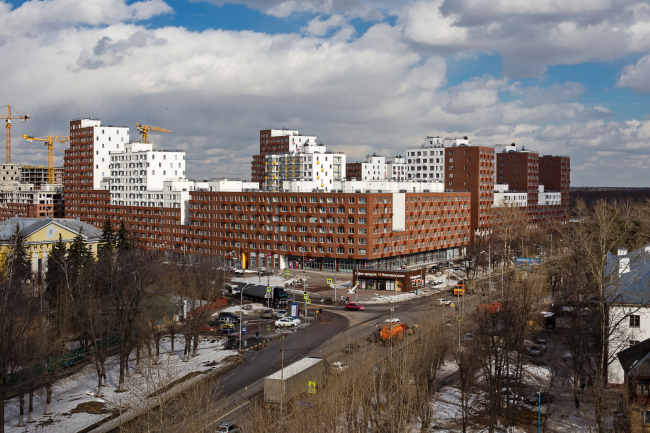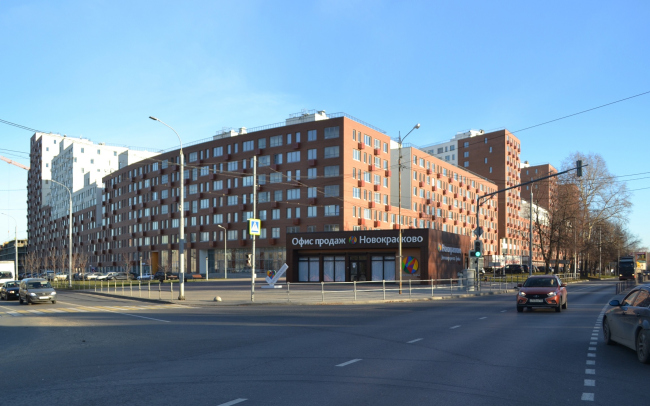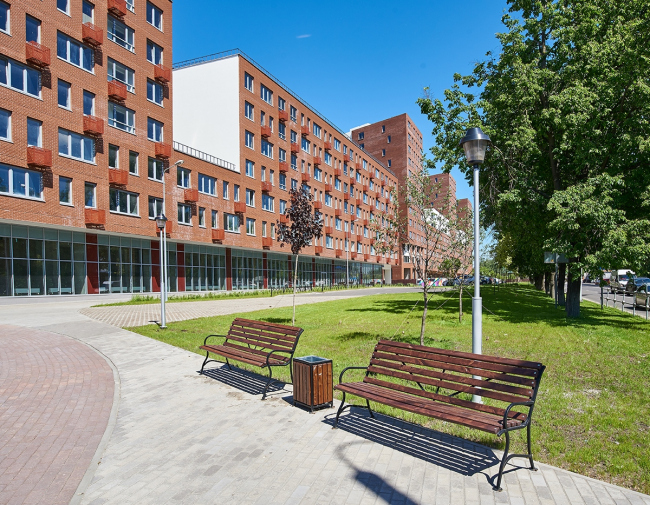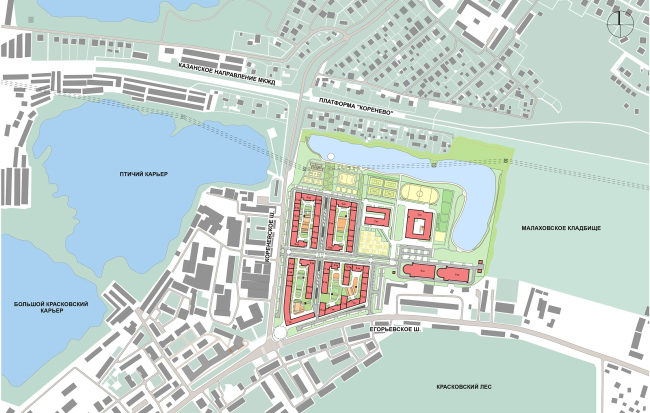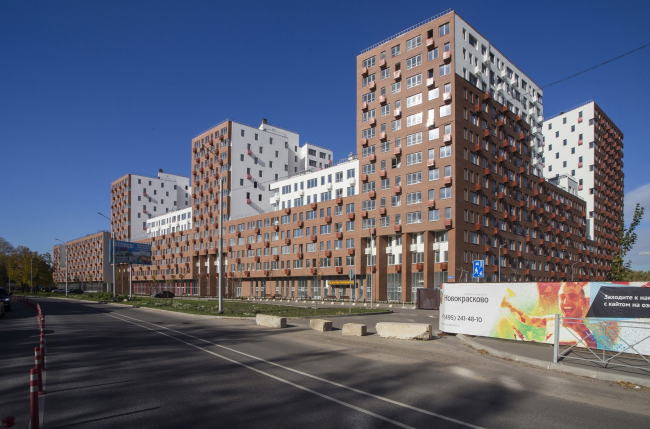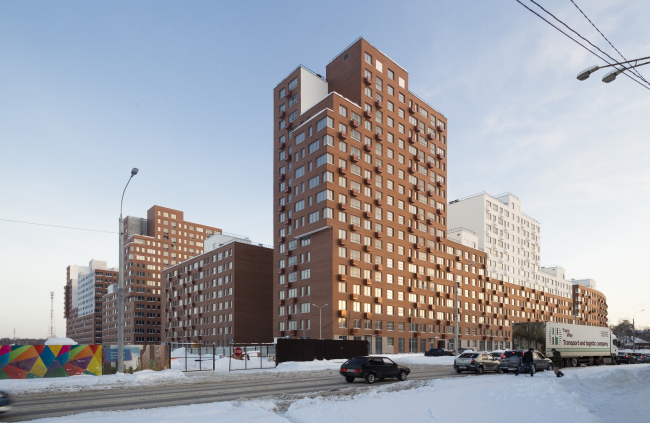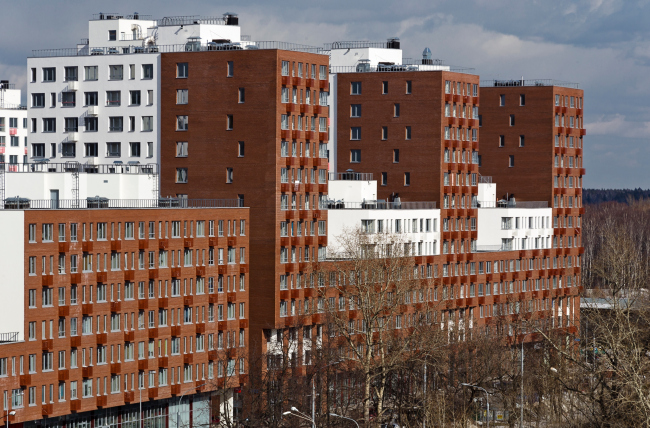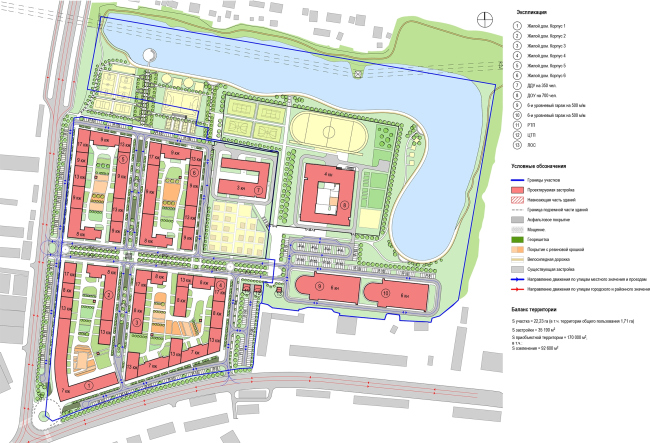|
Published on Archi.ru (https://archi.ru) |
|
| 25.03.2019 | |
|
A Town Within a Suburb |
|
|
, Julia Tarabarina |
|
| Architect: | |
| Alexander Skokan | |
| Dmitry Gusev | |
| Studio: | |
| Ostozhenka Bureau | |
|
The construction of the first stage of “Novokraskovo” housing complex has been completed. Two city blocks set quite a different rhythm to the surrounding territory of the settlement: the new complex comes in larger increments, yet at the same time it is more flexible and diverse – of the true urban type. Novokraskovo housing complex. View from the corner of Korenevskoe and Egoryevskoe highwaysCopyright: © Ostozhenka BureauWe already covered the housing project of “Novokraskovo”: it consists of four large city blocks on the Egoryevskoe Highway lying 15 kilometers off the Moscow Ring Road, east of Lyubertsy. Essentially, this is a countryside place, not far away from the proverbial town of Malakhovka but currently it is mostly dominated by multistory buildings – and the work of Ostozhenka Architects became the first example of design architecture here. The settlement of Kraskovo is particularly known for its sand quarries: a result of the work of the Korenevsky plant of building materials (founded in 1930, just as Malakhovka), they were later on flooded over and turned into manmade lakes. Novokraskovo housing complex. Top viewCopyright: © Ostozhenka BureauThe residential complex is occupying the territory of a former military base situated between the highway, the Chekhova Street and the Novokraskovsky Quarry Lake: the latter is sort of hazardous to swim in but still there is a semblance of a sand beach on the other shore. Until recently, this place looked all but : the classic lopsided trees peeking from behind the sickeningly familiar concrete fence of the military base. Now it has turned into a full-fledged urban area – in front of terra-cotta brick façades, at the crossroads, a small Y-shaped square appeared thanks to a slight turn of the corner building: this space “pause” or “rest” gave extra meaning to the crossroads. It even looks as though the surrounding greenery has decided to live up to the new standards – now it looks almost like a park. It is only the laconic volume of the sales office, saluting to the cars driving down the highway, that lets us know that it wasn’t always this way here. According to the project, the office building will later be replaced by a sculpture with a clock – a clear indication of the city importance of this square. Novokraskovo housing complex. View from the crossing of Korenevskoe and Egoryevskoe highwaysCopyright: © Ostozhenka BureauNovokraskovo housing complexCopyright: © Ostozhenka BureauCurrently, two city blocks out of four have been built – the first and second stages, houses 1-4. Novokraskovo housing complex. Master planCopyright: © Ostozhenka BureauThese two blocks, however, are larger than the other two, which will be built more to the north on the lake shore – and, in addition, they are more representative-looking. It is these particular blocks that are essentially the face of the complex, and, it must be said that already now – at least, for the cars passing by – it looks like quite a complete architectural project. The bend of the façade in front of the square, however small compared to the scale of the complex at large, is a very important stylistic device: this “author’s signature”, very delicate and reserved, demonstrates both bending plastique and, if viewed from certain angles, the sharpness of the corner “nose” that takes on the role of the main façade of the entire complex. Therefore, the tall bottom floor is fully glazed and sunken in – the volumetric cutaway is enough to create an effect of an overhanging mass above the transparent ground floor. Novokraskovo housing complex. View from the squareCopyright: © Ostozhenka BureauCafes, shops, and public spaces will occupy the bottom floors of the outside contour; one of the sections will host a children’s clinic, which is already popular with the local residents. However, the bottom floors of different buildings are designed differently: the theme of modernist “stripe” is sometimes continued, and sometimes it dies away, the buildings losing in their height. Along the length of the highway, the band of the bottom floors is intercepted by three groups of pylons that cover two floors, one on top of the other – “porticos” at the base of the towers. Novokraskovo housing complex. Overview from the Egoryevskoe Highway, Moscow-boundCopyright: © Ostozhenka BureauThe design of the bottom floors on the “yard” side is more interesting still: there are lots of galleries here, resting on pillars sometimes one and sometimes two stories tall. They make it possible to interpret the vehicle-free yards as inland “mini-squares”. The pillars are mostly white, the gallery walls behind them being subjugated to a color code: orange, red, and cadmium yellow colors are assigned to specific buildings, and they also appear in the arches that serve as gateways to the yards, elevator lobbies with pram storage rooms, and the corridors on each floor. The color casts overtones and gives some extra intrigue to the depth of the galleries. This effect was used by the architects in the “Akvareli” (“Watercolor”) housing complex located comparatively near, in Balashikha, which was completed six years earlier. This housing complex, just many other buildings designed by Ostozhenka, is echoed by a sophisticated structure of volumes that combines “beams” with “towers” and is abundant in cutaways, which turn out to be both a “compulsory measure”, i.e. the result of searching for the optimum insolation solution – and, at the same time an artistic device that enriches both plastique and silhouette. What also makes this complex akin to “Akvareli” is also the architects’ love for white color – which easily reflects other colors and sunlight. In this particular instance, the architects settled on white stucco, both for economy and imagery reasons. 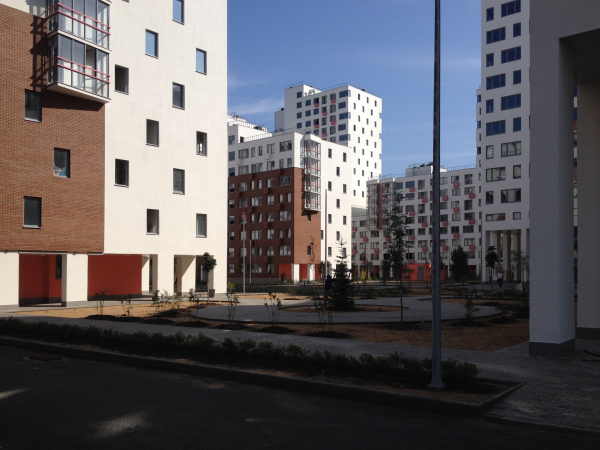 Novokraskovo housing complex. View of the yard of the second blockCopyright: © Ostozhenka Bureau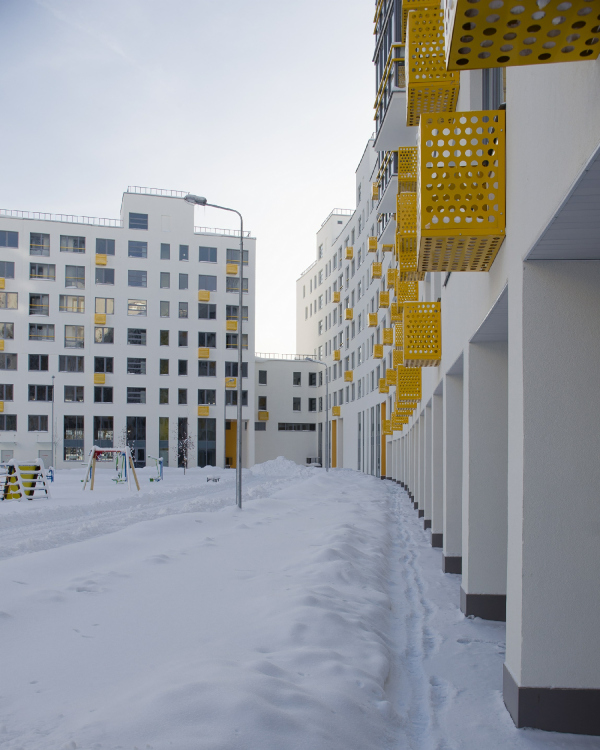 Novokraskovo housing complex. View of the yard of the first block © Novokraskovo housing complexCopyright: © Ostozhenka Bureau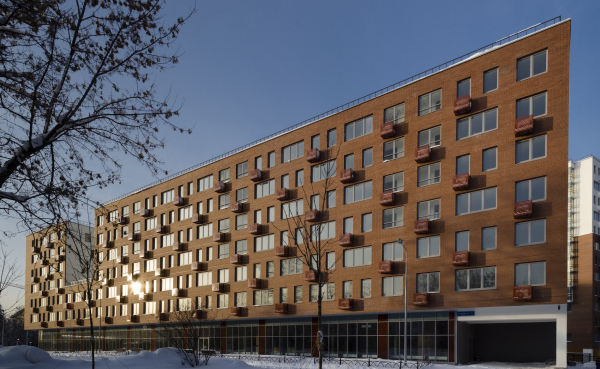 Novokraskovo housing complex. View of the first block from the Egoryevskoe highwayCopyright: © Ostozhenka Bureau Novokraskovo housing complex. A facade fragmentCopyright: © Ostozhenka BureauBut then again, in spite of these similarities, the complexes are completely different. “Novokraskovo” is much more about the “fortress” theme, very much like a silhouette outline of an Italian castello – which is boosted by externally brick façades and towers, especially those three that stand along the highway, at the basis of which the pylons of the “porticos” appear. But then again, it does not go any further than a mere hint: just as important is the image of the “city at large”, a complex multi-height and multicolored structure. The white color mostly belongs with the yards but it also appears on the outside façades; the brick also “leaks inside”, reminding us of a jigsaw puzzle of numerous interconnected differently colored pieces or a snow iceberg melting inside the brown crust. The sculptural image is dictated, among other things, by the insolation requirements – the architects explain – but it is strengthened by the “introduction of white stucco fragments into the outside perimeter and, the other way around, brick ones into the yards” – in order to avoid the effect of lengthy façades of equal height along the perimeter of the complex. 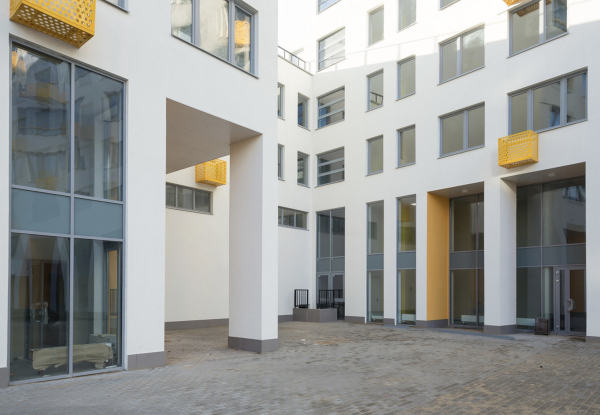 Novokraskovo housing complex. View of the yard of the first blockCopyright: © Ostozhenka Bureau Novokraskovo housing complex. View of the building of the first blockCopyright: © Ostozhenka Bureau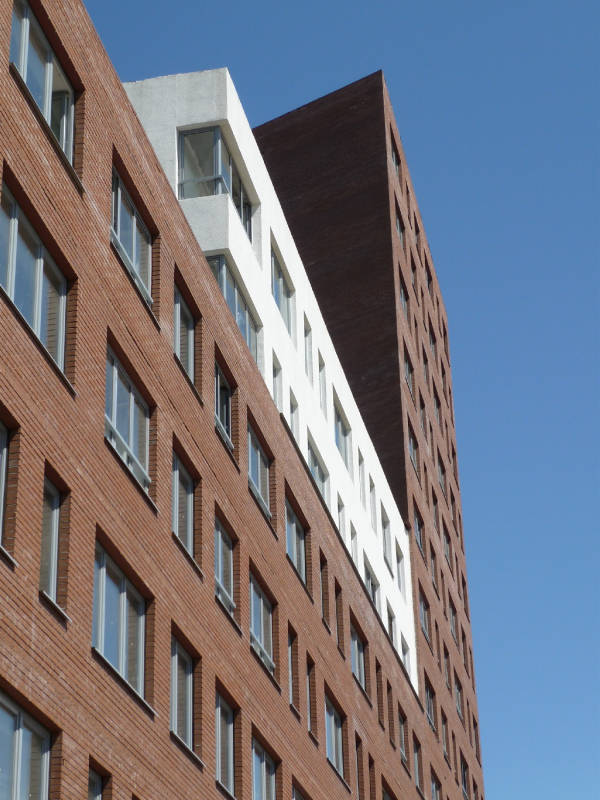 Novokraskovo housing complex. A facade fragmentCopyright: © Ostozhenka Bureau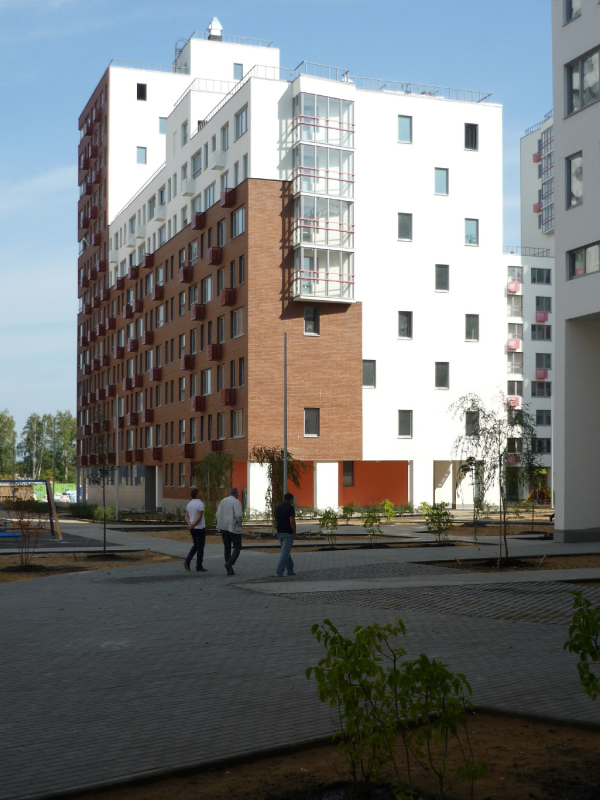 Novokraskovo housing complex. View of the building of the second blockCopyright: © Ostozhenka Bureau“Both these materials are naturally warm and really homely – the architects explain – and on the sensitive level, however different, they are perceived as being of the same kind, and they beautifully complement each other. In the vein of this solution, dictated, among other things, by economic reasons, we made the choice of color and stucco, and designed the façade surfaces”. Novokraskovo housing complex. Overview from the Korenevskoe HighwayCopyright: © Ostozhenka BureauThis is not all there is to it, however: depending upon their location, the façade materials get different rhythms of alternating vertical and horizontal windows. On the brick façades, it is strictly chessboard-like, the narrow windows being grouped in twos that look very much like a pair of eyes above the wide open mouth of the horizontal window. In the yards, the rows of windows become more agile and form punctured lines. The white side ends are getting pristine diagonal compositions of small openings that distantly resemble the façade grid of the Melnikov House. The strict diagonal rhythm is also supported by the casings of the air conditioning units – on the outside façades they are painted the color of the walls and thus merge with the brick and white colors alike. Inside the yards, the casings also become a color code element. The casings are factory-painted, while the round openings in the metal help the “little balconies” to perform the expected decorative function. In combination with the colorful slants and the dazzling white of the wall everything looks fresh and pure. The balconies, which are sunken in to be on a level with the wall on the façades, turn into bay windows on the yard side, getting a slight sideways turn and their share of color. 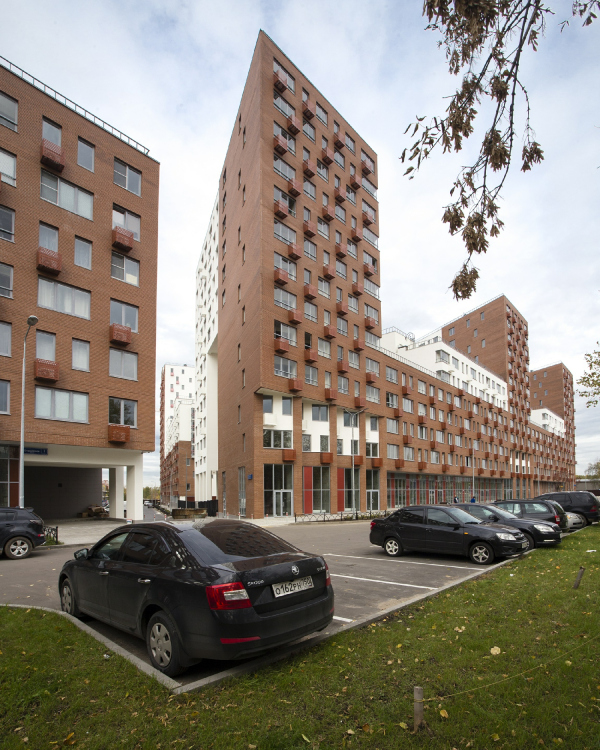 Novokraskovo housing complex. View of the second block from the Egoryevskoe HighwayCopyright: © Ostozhenka Bureau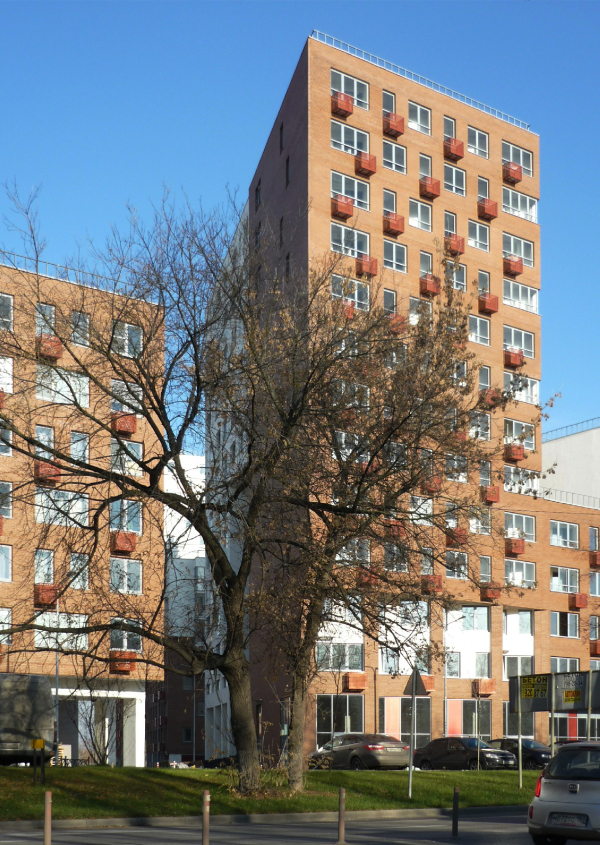 Novokraskovo housing complex. View from the Egoryevskoe highwayCopyright: © Ostozhenka Bureau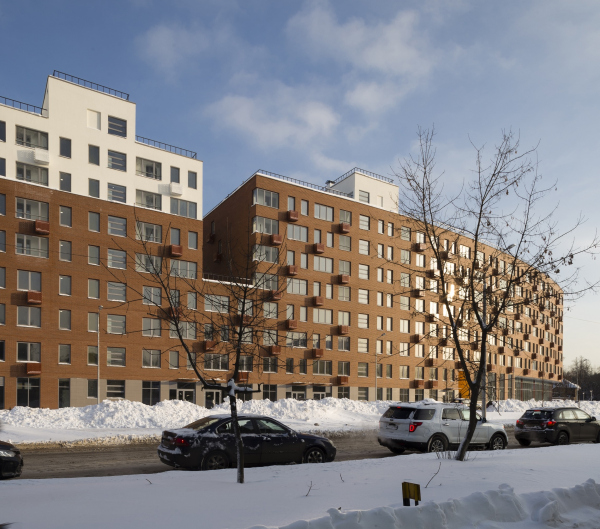 Novokraskovo housing complex. View from the Korenevskoe highwayCopyright: © Ostozhenka BureauOf course, the sophisticated silhouette of the complex is defined by the balance between the required output of square footage, insolation requirements, height restrictions, and town planning logic. This is why the corner building, the one that faces the crossroads and the square, is seven stories high. It serves as a transition link between the complex and the surrounding houses that are mostly two or three stories high standing behind the trees – and ensures a comfortable city scale. Further on, on either side, the volumes grow higher up to a maximum of 17 floors. One must say that on the other side of the Chekhova Street (which is also the Korenevskoe Highway), on the territory of the Construction Research and Development Institute, the Vyacheslav Bogachkin Architects designed a housing project of the same height, and, therefore, in the course of the design work, Ostozhenka Architects had to take into account not only the already-existing buildings but also this neighboring project; but then again, it is not yet clear if the latter will be actually built.  Novokraskovo housing complex. The 1st floorCopyright: © Ostozhenka Bureau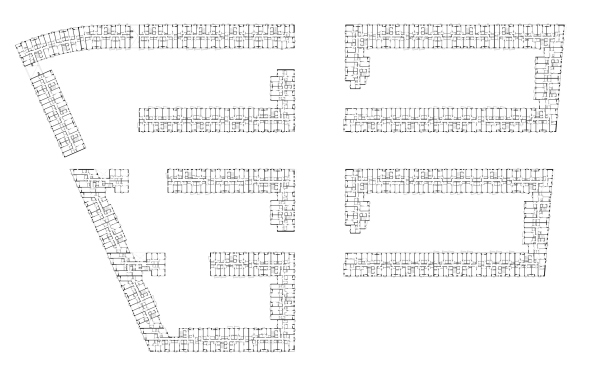 Novokraskovo housing complex. The 5th floorCopyright: © Ostozhenka Bureau Novokraskovo housing complex. The 14th floorCopyright: © Ostozhenka BureauOne of the important narratives of the project is the system of green spaces that penetrating the entire residential area. Arrays of new, so far small, trees separate the complex from the street and the highway, and surround it along its perimeter. On the inside of the complex, there will be a crossing of two boulevards. On the one hand, they will serve as the inside traffic arteries, and, on the other hand, they are connected by pedestrian links with landscaped vehicle-free yards and the quarry lake shore. The construction of a school and underground parking garage is still debated because they would have to be built on alluvial lands, and the local residents protest against filling some of the lake. The construction of a kindergarten, which is located closer to the residential buildings, has already begun. Novokraskovo housing complex. Top view, a fragmentCopyright: © Ostozhenka BureauIn spite of the rather sophisticated composition of volumes, the architects were still able to avoid sharp angles in their planning solutions and get the required diversity of apartment floor plans – from small studios to spacious three-room apartments. Virtually all of the curvilinear surfaces conceal stanza balconies that make it possible to solve the task of making sure that the rooms nevertheless have regular measurements; some of the apartments of the first, second, and third floors are enlarged in order to get the required amount of sunlight. Going higher up, the architects unified the floor plans, considering the fact that the project is essentially economy class. The corridors are rather long at times, leading to 7-8 small apartments, which is crucial for space-efficient planning.  Novokraskovo housing complex. Development drawing along the inner boulevardCopyright: © Ostozhenka Bureau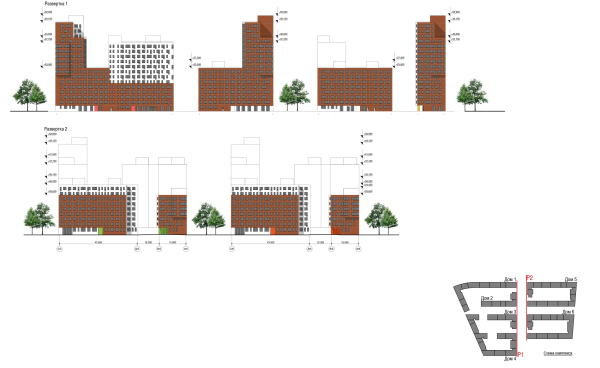 Novokraskovo housing complex. Development drawingsCopyright: © Ostozhenka Bureau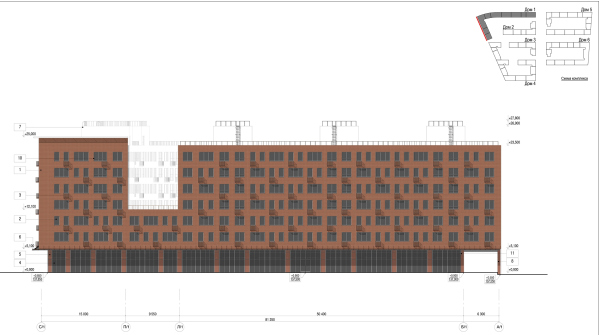 Novokraskovo housing complex. The facade schemeCopyright: © Ostozhenka Bureau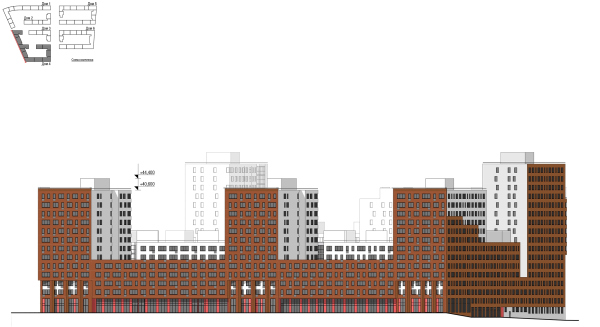 Novokraskovo housing complex. The facade schemeCopyright: © Ostozhenka Bureau Novokraskovo housing complex. Development drawingsCopyright: © Ostozhenka Bureau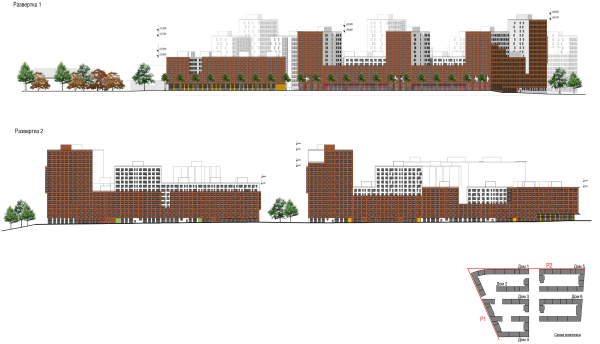 Novokraskovo housing complex. Development drawingsCopyright: © Ostozhenka Bureau Novokraskovo housing complex. Facades, Buildings 2 and 3 © Novokraskovo housing complexCopyright: © Ostozhenka Bureau Novokraskovo housing complex. Facades, Buildings 5 and 6 © Novokraskovo housing complexCopyright: © Ostozhenka Bureau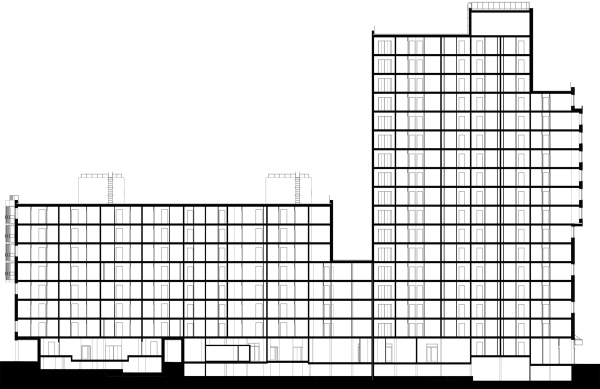 Novokraskovo housing complex. Longitudinal section view, Building 3 © Novokraskovo housing complexCopyright: © Ostozhenka Bureau Novokraskovo housing complex. Longitudinal section view, Building 4 © Novokraskovo housing complexCopyright: © Ostozhenka Bureau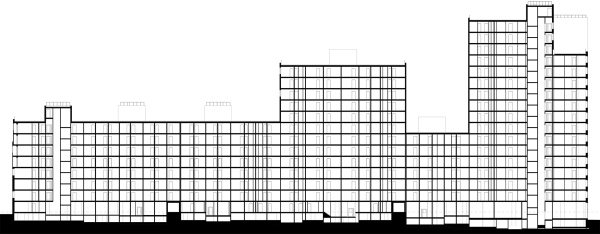 Novokraskovo housing complex. Longitudinal section view, Building 5 © Novokraskovo housing complexCopyright: © Ostozhenka BureauOstozhenka Architects have long since developed their own methods of creative and productive work with large-scale housing projects: they inevitably turn out to be big – yes – but still recognizable and having a unique identity of their own. When still in the concept stage, the architects considered a prospect of building a few towers here, yet the project ultimately ended up being made of perimeter city blocks sporting a picturesque silhouette formed by rhythmically placed tower-like volumes. The complex became one of the logically grounded versions of implementing the idea that Ostozhenka Architects have been promoting for years – perhaps, from the day the company was founded – and which is still relevant today. Essentially, this residential area is a small town in its own right, which sets new standards of space organization to this actively developing formerly industrial area. Novokraskovo housing complexCopyright: © Ostozhenka Bureau |
|

